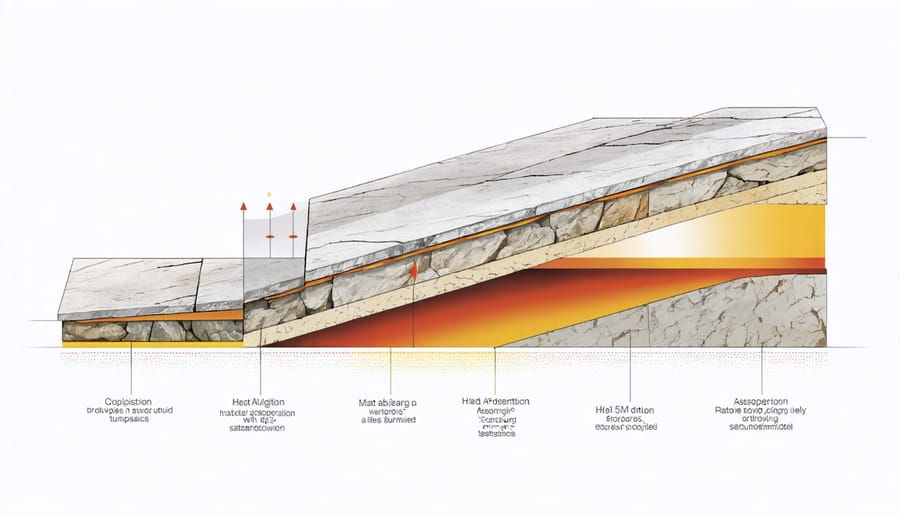Natural stone, long revered for its architectural beauty, emerges as a groundbreaking solution in sustainable energy systems. From ancient thermal mass applications to cutting-edge integration in sustainable IoT homes, stone’s inherent properties offer remarkable potential for energy generation and conservation.
Beyond its traditional role as a building material, stone’s crystalline structure and thermal characteristics enable innovative energy applications. Scientists have discovered that certain stones, particularly quartz and piezoelectric materials, can convert mechanical pressure into electrical energy. This breakthrough, combined with stone’s natural ability to store and regulate temperature, presents a dual advantage in modern construction: passive energy management and active power generation.
Recent advancements in stone-based energy systems have demonstrated up to 30% reduction in building energy costs while maintaining structural integrity. As global demands for sustainable building solutions intensify, stone’s renewable energy capabilities position it at the forefront of green construction technology, offering a perfect blend of historical wisdom and modern innovation.
Thermal Energy Storage in Natural Stone
Heat Absorption Properties
Different types of stone possess varying thermal management properties that make them invaluable for energy storage and temperature regulation in buildings. Dense stones like granite, basalt, and marble exhibit exceptional thermal mass capabilities, allowing them to absorb and store significant amounts of heat during the day and release it gradually when temperatures drop.
Granite, with its crystalline structure, can store approximately 0.8 kJ/kg·K of thermal energy, making it particularly effective for passive solar heating applications. Limestone and sandstone, while slightly less dense, still offer substantial heat retention properties, storing between 0.6-0.7 kJ/kg·K of thermal energy.
The color of stone also plays a crucial role in heat absorption. Darker stones typically absorb more solar radiation, while lighter-colored stones reflect more heat. This characteristic can be strategically utilized in different climate zones to optimize energy efficiency. For instance, dark granite or slate might be preferred in cooler regions for maximum heat gain, while lighter limestone could be more suitable for warmer climates.
The thickness of stone installations directly impacts their thermal performance. Generally, a minimum thickness of 4 inches is recommended for optimal thermal mass benefits, though this can vary based on specific application requirements and local climate conditions.

Energy Release Mechanisms
Natural stone’s thermal energy release occurs through two primary mechanisms: radiation and conduction. As stored heat dissipates, stones gradually emit warmth into their surrounding environment, creating a steady and controlled release of energy that can benefit building occupants.
In residential and commercial applications, this energy release is typically harnessed through strategic stone placement and system design. During nighttime or cooler periods, stones naturally release their accumulated heat, helping to maintain consistent indoor temperatures. This process is particularly effective in passive solar designs, where thermal mass walls or floors made of stone slowly discharge stored energy throughout the evening hours.
Modern building systems often incorporate sophisticated controls to optimize this release process. Temperature sensors and automated ventilation systems can work in conjunction with stone elements to manage heat distribution effectively. For instance, some designs utilize forced air systems that pass through stone-lined channels, allowing for controlled heat extraction and distribution throughout the building.
The rate of energy release can be influenced by several factors, including stone type, thickness, and surface treatment. Darker stones typically release heat more readily than lighter varieties, while polished surfaces tend to retain heat longer than rough-textured ones. Understanding these characteristics allows architects and designers to select the most appropriate stone materials for specific climate conditions and building requirements.
Passive Solar Design with Natural Stone

Strategic Stone Placement
The strategic placement of stone features within a building’s design plays a crucial role in maximizing energy efficiency and thermal performance. When integrated with modern smart building technology, properly positioned stone elements can significantly reduce energy consumption while maintaining optimal indoor comfort levels.
South-facing walls benefit most from dense stone materials that can absorb and store solar heat during winter days, releasing it gradually during cooler nights. This passive solar design principle, known as thermal mass, works most effectively when stone walls are exposed to direct sunlight through properly sized windows.
For summer cooling, stone features should be strategically placed to provide natural shading. Exterior stone walls or columns can be positioned to cast shadows during peak heat hours, while stone flooring in areas receiving indirect sunlight helps maintain lower indoor temperatures through natural cooling properties.
In outdoor spaces, stone pathways and patios should be arranged to minimize heat island effects. Light-colored stones reflect solar radiation, while permeable stone arrangements allow for better ground cooling through natural ventilation and water evaporation.
For optimal results, consider these key placement factors:
– Solar orientation and seasonal sun patterns
– Prevailing wind directions
– Local climate conditions
– Building usage patterns
– Integration with existing structural elements
The thickness and density of stone elements also influence their energy performance, with larger masses providing better thermal stability. Consulting with energy modeling experts during the design phase ensures optimal stone placement for maximum energy efficiency benefits.
Stone Types and Their Applications
Natural stone varieties play a crucial role in passive solar design, with different types offering unique thermal properties and energy-efficiency benefits. In modern stone architecture, certain materials have proven particularly effective for energy storage and temperature regulation.
Granite, with its high density and thermal mass properties, excels in heat retention and gradual release, making it ideal for flooring in sun-exposed areas. Its durability and variety of colors also contribute to its popularity in sustainable building designs.
Limestone offers excellent thermal mass capabilities while being more cost-effective than some alternatives. Its light color naturally reflects sunlight, helping to reduce cooling costs in warmer climates. It’s particularly effective when used in thick walls or as facing material.
Slate, known for its natural layering and durability, works exceptionally well in vertical applications such as wall cladding. Its dark colors absorb solar energy effectively, while its thermal stability helps maintain consistent indoor temperatures.
Sandstone provides moderate thermal mass properties and is especially suitable for exterior applications where both energy efficiency and aesthetics are priorities. Its natural porosity helps regulate humidity levels while storing thermal energy.
For optimal energy performance, these stones should be strategically placed based on sun exposure and local climate conditions. Thickness also plays a crucial role – generally, stones should be at least 4 inches thick to provide effective thermal mass benefits. When properly implemented, these materials can reduce heating and cooling costs by 20-30% annually.
Innovative Energy Applications
Geothermal Heat Exchange
Geothermal heat exchange systems harness the earth’s constant underground temperature by utilizing stone’s natural thermal mass properties. These systems typically involve a network of pipes buried beneath the ground, where stone and soil maintain a steady temperature of approximately 50-60°F (10-15°C) year-round.
Natural stone plays a crucial role in these systems by acting as a thermal battery. The dense composition of stone allows it to effectively store and transfer heat energy, making it an ideal medium for geothermal applications. When integrated into building foundations or underground installations, stone enhances the efficiency of heat exchange processes.
In residential and commercial applications, stone-based geothermal systems can reduce heating and cooling costs by up to 70%. The process works by circulating a heat-transfer fluid through underground pipes, where it absorbs heat from surrounding stone in winter and releases excess heat into the stone during summer months.
Modern geothermal installations often incorporate crushed stone or granite beds around the pipe network to optimize heat transfer. This approach maximizes system efficiency while utilizing readily available natural materials. The durability of stone also ensures these systems maintain their effectiveness for decades with minimal maintenance.
For optimal performance, designers typically specify dense stone types with high thermal conductivity, such as granite or basalt. These materials provide superior heat exchange capabilities while requiring less underground space compared to conventional soil-based systems.
Energy-Generating Stone Pathways
Recent innovations in sustainable construction have introduced remarkable technology that transforms everyday stone pathways into energy-generating surfaces. These innovative systems use piezoelectric materials embedded within or beneath stone pavers to convert mechanical stress from footsteps into electrical energy.
When pedestrians walk across these specially equipped stone pathways, the pressure from their footsteps creates mechanical strain on the piezoelectric crystals. This strain generates small electrical charges that, when accumulated, can power nearby lighting, signage, or be stored in batteries for later use.
Several successful implementations already exist in high-traffic areas. London’s Bird Street features energy-harvesting stone tiles that power LED lighting and create an interactive lighting display for pedestrians. Similarly, Las Vegas has installed these systems in popular tourist areas, generating enough electricity to power streetlights throughout the evening.
The technology is particularly effective in urban spaces with heavy foot traffic, such as transportation hubs, shopping districts, and university campuses. A single footstep can generate around 5 watts of power, and when multiplied across thousands of daily pedestrians, the energy output becomes significant.
While the initial installation costs are higher than traditional stone pathways, the long-term benefits include reduced energy bills, lower carbon emissions, and enhanced public engagement with sustainable technologies. The durability of natural stone ensures these systems maintain their efficiency for decades, making them an increasingly popular choice for smart city initiatives.

Cost-Benefit Analysis
The implementation of stone-based energy solutions presents a compelling economic case when evaluated over the long term. Initial installation costs for thermal mass systems and stone-integrated designs typically range from 15-30% higher than conventional building materials. However, these systems can reduce heating and cooling costs by 20-40% annually, offering a return on investment within 5-7 years.
Environmental benefits are equally significant. Natural stone requires minimal processing compared to manufactured materials, resulting in a lower carbon footprint during production. Studies show that stone-based thermal mass systems can reduce CO2 emissions by up to 30% compared to traditional HVAC systems. Additionally, stone’s durability means less frequent replacement, reducing waste and resource consumption over time.
Maintenance costs for stone energy systems are notably lower than mechanical alternatives. While traditional HVAC systems require regular servicing and component replacement every 10-15 years, properly installed stone thermal mass systems can function effectively for 50+ years with minimal maintenance requirements.
Case studies from commercial buildings utilizing stone energy solutions report average utility cost savings of $2.50-3.50 per square foot annually. For a typical 10,000-square-foot commercial building, this translates to approximately $25,000-35,000 in yearly savings. These figures become more favorable in regions with extreme temperature variations, where thermal mass properties provide maximum benefit.
The resale value of properties incorporating stone energy systems typically increases by 7-10%, offsetting the initial investment. Insurance companies often offer reduced premiums for buildings with stone-based energy solutions due to their fire-resistant properties and structural durability.
While the upfront costs may seem substantial, the combination of energy savings, reduced maintenance, increased property value, and environmental benefits makes stone-based energy solutions an economically sound choice for long-term sustainability. Government incentives and green building certifications can further improve the cost-benefit ratio, making these systems increasingly attractive to property developers and owners.
As we look toward a more sustainable future, natural stone emerges as a powerful ally in our quest for energy-efficient solutions. The inherent thermal properties and versatility of stone make it an invaluable resource in both traditional and innovative energy applications. From passive solar design to cutting-edge thermal energy storage systems, stone continues to demonstrate its remarkable potential in reducing energy consumption and supporting renewable energy initiatives.
The growing interest in stone-based energy solutions has sparked numerous research projects and technological developments. Scientists and engineers are exploring new ways to enhance stone’s natural properties, creating more efficient systems for energy storage and transfer. These advancements, coupled with improved manufacturing processes, are making stone-based energy solutions more accessible and economically viable for both residential and commercial applications.
Looking ahead, the integration of natural stone in sustainable energy systems is expected to expand significantly. As climate change concerns drive the demand for eco-friendly building materials, stone’s role in energy conservation and generation will become increasingly important. Future developments may include advanced composite materials that maximize stone’s energy-storing capabilities and innovative applications in solar thermal systems.
The sustainable energy potential of natural stone represents a perfect harmony between traditional building practices and modern environmental needs. By continuing to invest in research and development, we can further unlock the energy-saving capabilities of this remarkable natural resource, contributing to a more sustainable and energy-efficient future for generations to come.










